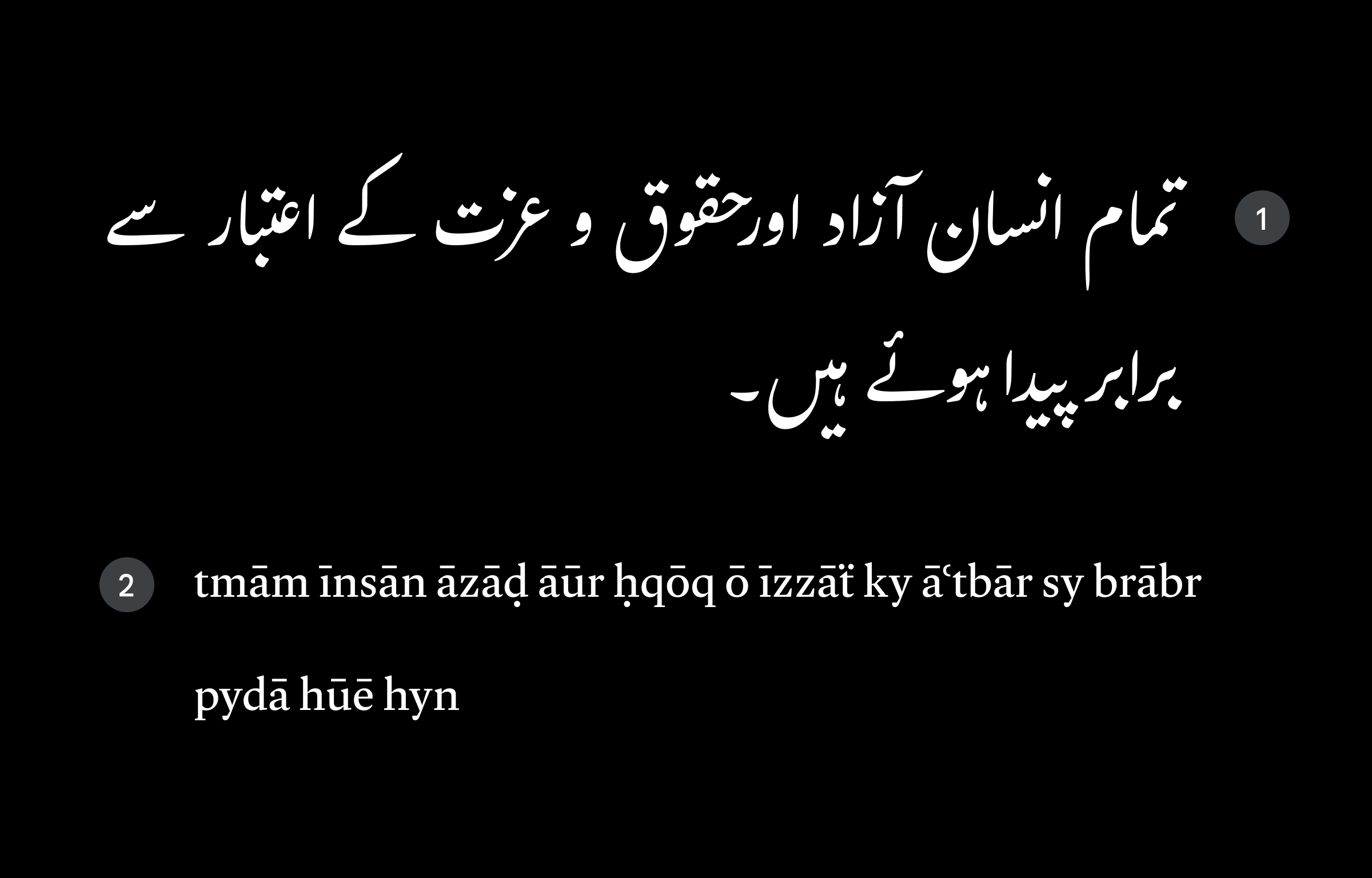
2. Gulzar Latin
"All human beings are born free and equal in terms of rights and dignity." In Urdu (Gulzar Nasta'liq) and transliterated in Latin (Gulzar Latin).
Gulzar is a contemporary Urdu Nasta’liq typeface – and its Latin counterpart – designed and developed through a collaboration by Borna Izadpanah (Principal Designer and Project Leader), Simon Cozens (Font Engineering), Alice Savoie (Designer, Gulzar Latin), Fiona Ross (Consultant, Gulzar Urdu), Amir Mahdi Moslehi (Calligraphic adviser, Gulzar Urdu) and Martin Dodds (Consultant, Gulzar Urdu). This typeface was designed to provide an effective textual communication tool primarily for Urdu readers on digital platforms and in print. In Gulzar, the aim has been to produce a typeface which is legible at text sizes and suitable for sustained reading. The first phase of this project involved conducting research into the history of Urdu digital typefaces from the early 1980s. The design of Gulzar was inspired by carefully collected specimens of Urdu calligraphy and lettering which were closely studied to achieve an accurate representation of the Urdu flavour of the Nasta’liq style.
Once the Nasta’liq design was firmly established, a proposal was made for a Latin counterpart that took inspiration from two eminent humanistic references: the versatile and sturdy proportions of Robert Granjon’s types, coupled with the sharp and distinctive feel of Hendrik van den Keere’s work. The Latin letterforms thus feature some subtle references to their calligraphic roots and echo the contrast present in the Nasta’liq, while remaining embedded in their classical typographic proportions.
Gulzar is not the first OpenType Nasta’liq typeface, but it is the first Nasta’liq type for which an original Latin counterpart was designed. It covers all the required transliterations characters to transcribe Arabic, Persian and Urdu languages.
You can read more about the inspiration, design, and engineering of Gulzar at gulzarfont.org.
To contribute, see github.com/googlefonts/Gulzar/.
Gulzar: Expanding the variety of Urdu Nasta'liq options

To give Urdu speakers more typeface choices, in July 2022, Google Fonts added Gulzar, a new Nasta'liq Urdu typeface.

Simon Cozens, Dr. Borna Izadpanah, and Dr. Fiona Ross conducted their own research and consulted with Urdu language specialists in Pakistan and the United Kingdom to create the Gulzar Urdu Nasta'liq typeface project. Gulzar means "flower meadow" in Urdu.
Izadpanah is a native Persian speaker from Tehran, Iran. He learned Nasta'liq as a model for Persian handwriting in primary school.
"Designing a digital Nasta'liq typeface was my long-held dream," Izadpanah stated. As the principal Gulzar designer, he conducted the preliminary research and drew the glyphs.
Ross was familiar with the Urdu language and type design from her language studies and earlier work on two Nasta'liq typefaces, Sheeraz and Qalmi, for which Linotype acquired a patent.
To make a modern digital font based on the Urdu flavor of the Nasta'liq style, Izadpanah studied the proportions, stroke modulation, and character features in calligraphy manuals and a collection of lettering specimens
To learn more, visit "Gulzar: Expanding the variety of Urdu Nasta'liq options" (English, Urdu) and "Why are there so few Urdu fonts?" (English, Urdu).